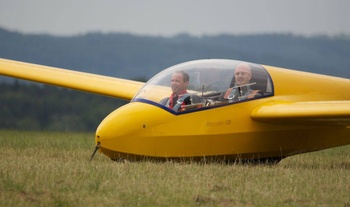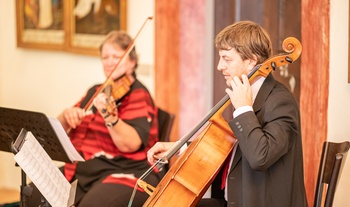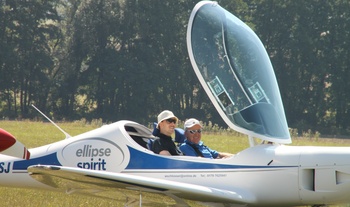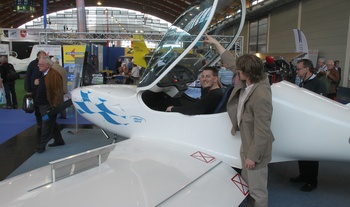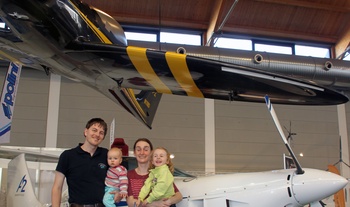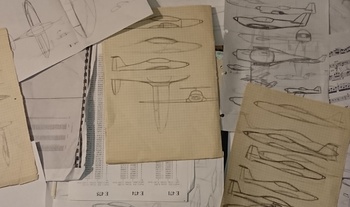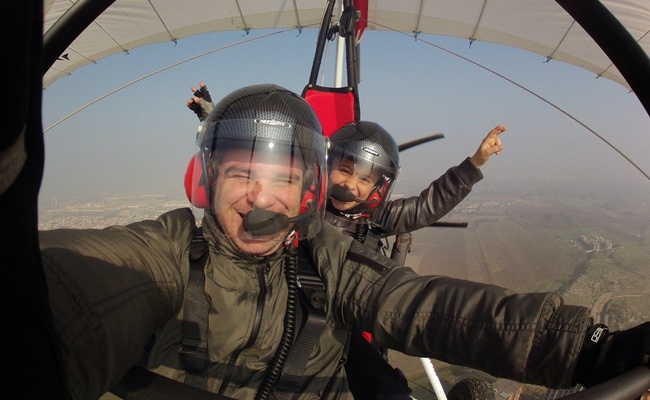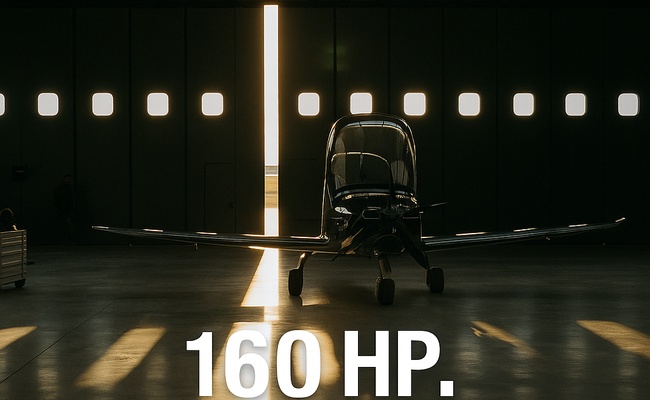Martin Vyskočil – father of ellipse
21. December 2021
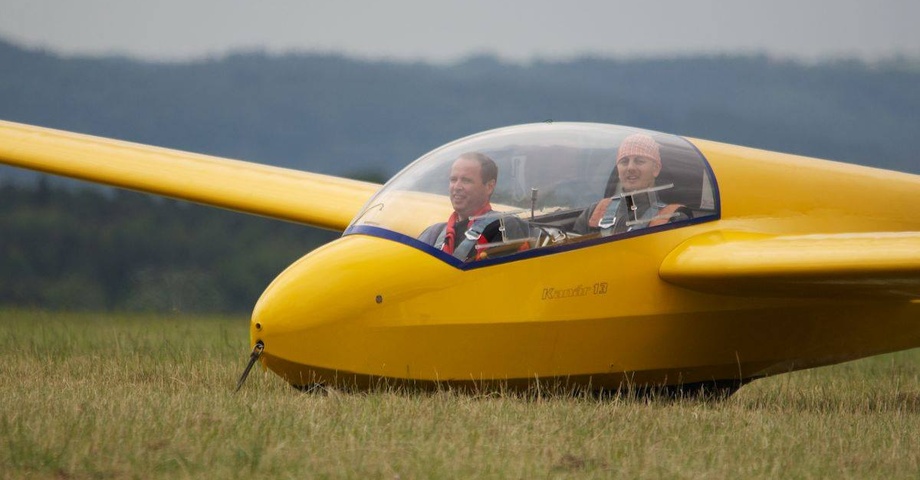
In a series of interviews, we would like to introduce you to the company and our aircraft through the eyes of those who work on it. The interviews always start with a brief biography in which the ellipse aero personalities introduce themselves. This is followed by an interview in which we ask questions about what is interesting to us and what we believe might be of particular interest to you.
We begin with Martin Vyskocil, the spiritual father of ellipse.
I was born in Turnov in January 1981. Our family has never had anything to do with aviation. At first, it didn't seem that my life's journey was at all about aeroplanes, I was interested in trains, music and astronomy.
In fact, my path to aviation was paved all the way from the very beginning and with no shortcuts. I started with plastic kits (connected logically with the study of aviation history) and in grammar school I eventually moved on to flying free-flying and RC models. However, I didn't enjoy building from kits or from plans. I was more inclined towards my own creations, which often turned out accordingly.
At the age of eleven, I flew for the first time in an aeroplane and from then on I was pretty clear. At the age of sixteen, I joined the aeroclub in Hodkovice nad Mohelkou and started my glider training. But I had to earn money for it, so I spent hundreds of hours there on part-time jobs, mostly maintaining gliders.
Little by little I completed the whole training under the guidance of Hanka Vokřínková, at that time already a very successful representative. I passed the pilot test at the time when I was entering my final year at Turnov high school. After graduation, I started to study at the Faculty of Mechanical Engineering of the Brno University of Technology.
At the faculty, I studied aircraft design at the Institute of Aerospace Engineering. I graduated in 2005 with a defence of a study of a two-seater glider for basic and advanced training. I also started my PhD studies, which I did not complete. However, this phase of my life is important because, among other things,
I had already started working on the design of an ultralight aircraft, which became the Ellipse, for which I am the author of all the external geometry and some of the aerodynamic calculations.
Do you remember your first flying experience? What was your first flight in and what was it like?
My first flying experience was in 1992 at the airfield in Hodkovice nad Mohelkou. It was a 10-minute scenic flight in a Vivat motor glider. I remember the moment when the plane lifted off the ground, the rumbling of the landing gear stopped and I watched our retreating shadow on the ground. Although it was a gasping Vivat, it seized me in such a way that from that moment on I craved to connect my future with aviation.
You are still an active pilot today and speaking of firsts, what was your first solo? Do you remember it?
My first solo was near the end of the season. It was an inversion and the air hardly moved. Inspector Sázavský sent me into the air. I was nervous and I had to sing in the aerotow. After a few minutes it fell off me. Blaník obeyed the word the whole time. I had flown quite a lot of hours and takeoffs during the training, so it went without any problems and with a nice landing.
Much more interesting was the second solo a few days later, which was done on a winch with a strong crosswind. This also went well and I gained my first real confidence in my piloting abilities.
What led you to study aeronautical design?
In grammar school, I couldn't decide what I wanted to do until about the fifth grade. I was even considering a conservatory. Joining the aero club made a major difference. At that time my dad found an article in L+K magazine about the Institute of Aerospace Engineering at the Brno University of Technology under prof. Píštěk management and I found out that this is exactly what I wanted to study. So from the age of sixteen, I knew exactly what school and what department I wanted to go to.
Did college fulfil your ideas about your future profession?
Actually, it did. The college explained exactly what we were going to do in practice and they certainly didn't lie to us. I think we left school for practice pretty well equipped with knowledge and experience with typical software used in aviation.
As an aerospace engineer, what do you value most in your work so far?
Most of all, I appreciate the opportunities and trust I have been given. The first and one of the greatest of these was the offer to work on the ellipse, right out of school.
What has been the biggest disappointment you have experienced in your work so far?
The biggest disappointment for me was the dissolution of the Choceň company Schempp-Hirth. At that time, we wrote a project with them for a new Czech school glider, which eventually succeeded among the Trend projects. The young guys from Choceň had already developed it as VSO-13.
It was perhaps even agreed that the glider would belong to the portfolio of the German Schempp-Hirth, because they do not have a school glider, so it should have been supported throughout their business network. Instead, we had an excursion into the tunnels of the nineties and probably the last meaningful chance to develop and build a replacement for the Blanik in this country was lost.
How do you recognize success in your work? How do you know if your work is successful?
That's probably hard to say. As an engineer, I consider success when something works well, has technical beauty, and the pilots appreciate the product. Over time, I've come to recognize that success is easily measured in monetary terms and not necessarily associated with some sophisticated solution.
And personally, I consider it a success that I was able to fulfil one of my lifelong dreams - that is, to ride in an aeroplane of my own design. Because of the long development cycles, you have to be patient because you will only know if the aircraft is successful or not after a delay of several years.
Are there any technologies emerging that are moving aviation and your work forward?
For a long time, it has been computing and computational optimization methods that have fundamentally pushed aeronautical design to where it should be – that is, at the limits of material and given safety. Simply doing so allows the efficiency of the design to be maximized.
Along with this is the development, and more importantly, the availability of materials. I'm thinking, for example, of prepregs, which until recently were financially out of reach for ultralight aircraft manufacturers. Today, this is no longer the case. In addition, this technology significantly reduces the influence of the human factor in production, directly related to the increasing quality of the aircraft's construction and performance.
Alternative propulsion and related technologies are also bringing a significant change to aviation. These will naturally result in different aircraft (for example, due to different mass distribution or alternative propulsion methods, etc.) and may bring objective improvements in some aircraft parameters.
But I think we will have to wait a few years for these technologies' broader practical experience and objective benefits on a larger scale. But the development is clear, and it would probably be a mistake to avoid it.
Has flying become intertwined in your personal life? How does work fit in with your personal life and other interests?
I am still and probably will be the only one flying in our family, so logically I have to divide my time fairly between flying and family. Unfortunately, I spend most of my week working outside the home, so there's not much time left. I'm lucky that it has primarily become a hobby with my job, so I still enjoy working and look forward to it.
Other than that, though, it's a job like any other that requires its own amount of time, and it doesn't really matter much where I'm working. It's pretty easy to combine it with different interests. They include playing the cello and when there is time, RC models building, which can be done in the evening.
What was your path to ellipse?
Actually, awfully fast. A year after graduating from the aircraft department, I was on the faculty for a full-time PhD. And one day, a couple of colleagues and I were asked if we wanted to design an ultralight aircraft. It was literally, "Draw whatever you want, and we'll build it."
This is the dream of probably every recent graduate. Of course, we didn't hesitate and designed the first prototype of the ellipse. It looked slightly different then, but it already had an elliptical wing.
What, from your professional point of view, makes ellipse special? Interesting? Different? Fun?
From the beginning, we wanted to design an aircraft that would be distinctly different from all other designs. The ellipse is unique in many ways, but the most important is the wing. There was a strong emphasis on speed and safety in the brief requirements, which ultimately led us to a unique wing.
The slots, originally used mainly for safety reasons, made the ellipse an aircraft with exceptional performance, which worked well with the customers. As a result, the ellipse has an unrivalled range of speeds thanks to its wing, with stall speeds well below regulatory requirements and cruise speeds well above standard thanks to the efficient lift mechanism. However, it is not just the wing that is unusual.
The ellipse doesn't deny that its creators were glider pilots, so in addition to its aerodynamic purity, it shares many features with gliders. For example, the way the wing is joined to the fuselage makes it possible to quickly disassemble the aircraft. It also has a T-shaped tailplane, and the first prototype even had brakes to allow for faster descend if the aircraft was used for glider lifts.
Also unique is the interior, which is top of the class in width with a roomy luggage compartment where you can load a lot of stuff. There's also a hinged instrument panel for easier boarding, optional steering between classic stick and side sticks, and two cabin overlay options.
So yes, the ellipse is definitely exceptional and, thanks to its efficient handlebars and overall agility, I dare say fun. In fact, she's just the way we wanted her to be: A slightly different aircraft that grabs attention everywhere it goes and manages to grab the pilot by the heart.
What are the design steps you took to get there?
The fundamental requirement for the aircraft was speed and safety. We subordinated the aerodynamics to that speed and chose an elliptical wing. At the same time, we wanted an efficient lift mechanism for a comfortable and safe landing. When we combined these two elements, we had to solve the problem of how to ensure safety against flow separation on the ailerons. And we found that installing a slot was a better solution than the conventional wing twist.
The wing remained as a textbook ellipse, yet we could provide high wing separation safety at minimum speed even in the landing configuration. The wing also gained a significant passive safety feature that protects ailerons against the flow separation in all flight modes (including airspeed). In cruise mode, the flow through the slot is naturally locked and thus does not contribute significantly to the increased drag of the wing, which has been demonstrated in practice.
What are you working on now? What will be changed or improved on the ellipse soon?
We are currently working on new engine covers that will allow us to match the geometry for the full range of engines on offer and which will also revitalise the look of the ellipse. There will also be an optimisation of the flow in the engine compartment, which will contribute to greater reliability and probably to greater engine efficiency, which could also be reflected in performance.
For future, the possible intergenerational material change or the possibility of making some optimisations suggest that the ellipse has not yet fully exhausted all the potential that lies in its concept. And I look forward to seeing it be exploited.
What's the question you've always wanted to get and never got around to?
When I was studying aircraft design, I dreamed of maybe someday being able to draw an aeroplane. Not that aircraft construction graduates don't draw aeroplanes, that's for sure. But as we were told, we were most likely to become experts in the practice of the nineteenth baffle in the fuselage, which, among other things, I was able to try. I was lucky enough to draw the whole plane, though, and almost straight out of school.
And I thought one would be enough, and then I'd be happy. But I found that the food's appetite grew, and I wanted to draw another one. The chance came fifteen years later, and it's an entirely different plane. Again, it's fantastic, and I'm already hoping for more to come. So the question: Is one enough? Absolutely not! But beware, it's highly addictive...
